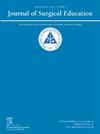Impact of Interview Modality on Gender Disparities in Plastic and Reconstructive Surgery Residency Match Success
IF 2.6
3区 医学
Q1 EDUCATION, SCIENTIFIC DISCIPLINES
引用次数: 0
Abstract
INTRODUCTION
The transition from in-person to virtual visits during the COVID-19 pandemic transformed the residency application process. Recognizing the gradual return to in-person interviews and the historical presence of gender disparities within medical fields, the present study sought to evaluate how interview modality influences the success rates of applicants to Plastic and Reconstructive Surgery (PRS) residency programs, with a focus on gender and applicant characteristics.
METHODS
Data on PRS residency applicants to a single integrated Plastic and Reconstructive Surgery program from 2017 to 2021 (4 application cycles) were obtained from the Electronic Residency Application Service (ERAS), National Residency Matching Program databases, and public online sources. The dataset included demographics (gender, race, orphan status), academic and professional qualifications (research year participation, Alpha Omega Alpha [AOA] and Gold Humanism Honor Society [GHHS] memberships, USMLE Step 1 and 2 scores, reapplicant status, type of medical graduate, additional degrees), interview modality (virtual or in-person), and match results. Specifically, interviews in the 2017/18, 2018/19, and 2019/20 cycles were in-person and those that took place in the 2020/21 application cycle were virtual. Data analysis included univariate regression with chi-squared test and multivariate logistic regression to assess the impact of virtual interviews on match success across genders and other factors.
RESULTS
A total of 1298 applicants (573 females, 724 males, 1 uncategorized) were included in the analysis; 985 (75.9%) underwent in-person interviews, and 313 (24.1%) had virtual interviews. There was a predominance of males with in-person interviews (58.2%) and females with virtual interviews (51.4%) (p = 0.002). The overall match success rate was 63.5%, with virtual interviews having a lower match rate (56.9%) compared to in-person (65.5%) (p = 0.004). Gender analysis revealed that female applicants had a higher overall match rate (67.2%) than males (60.5%) (p = 0.008). Notably, females had 37.9% higher odds of matching compared to males (p = 0.006). Specifically, the majority of applicants who successfully matched with in-person interviews were male (56.3%), and the majority of those who matched with virtual interviews were female (57.9%) (p = 0.001). Gender was not a significant determinant in match rates when considering other characteristics (p = 0.213). Race played a crucial role (p = 0.011), with Asian, Hispanic, and other race categories associated with overall lower match success (p = 0.004, p = 0.049, p = 0.045). Participation in a research year was positively correlated with match success (p < 0.001). Being a previous graduate at the time of application (as opposed to being a senior medical student at the time of application) had a negative correlation (p < 0.001). Reapplicant status had no significant impact (p = 0.213, p = 0.650).
CONCLUSION
Virtual interviews for PRS residencies led to lower overall match rates compared to in-person interviews, with varying outcomes based on gender and race. Applicant success was additionally influenced by personal and career-related factors, such as race and research activity. These findings underscore the complexity of residency selection processes.
访谈方式对整形重建外科住院医师匹配成功率性别差异的影响
在2019冠状病毒病大流行期间,从面对面访问到虚拟访问的转变改变了住院申请流程。认识到面对面面试的逐渐回归以及医学领域性别差异的历史存在,本研究试图评估面试方式如何影响整形与重建外科(PRS)住院医师计划申请人的成功率,重点关注性别和申请人特征。方法从电子居留申请服务(ERAS)、国家居留匹配计划数据库和公共在线资源中获取2017年至2021年单个综合整形和重建外科项目(4个申请周期)的PRS居留申请数据。数据集包括人口统计数据(性别、种族、孤儿状况)、学术和专业资格(研究年度参与情况、Alpha Omega Alpha [AOA]和金牌人文主义荣誉协会[GHHS]会员资格、USMLE第1步和第2步分数、重新申请者状态、医学研究生类型、额外学位)、面试方式(虚拟或面对面)和匹配结果。具体来说,2017/18、2018/19和2019/20周期的面试是面对面的,而2020/21申请周期的面试是虚拟的。数据分析采用单变量回归卡方检验和多变量logistic回归评估虚拟面试对跨性别和其他因素匹配成功的影响。结果共纳入1298例患者,其中女性573例,男性724例,未分类1例;985人(75.9%)接受了面谈,313人(24.1%)接受了虚拟面谈。面对面访谈的男性占58.2%,虚拟访谈的女性占51.4% (p = 0.002)。总体匹配成功率为63.5%,虚拟面试的匹配率(56.9%)低于面对面面试(65.5%)(p = 0.004)。性别分析显示,女性求职者的总体匹配率(67.2%)高于男性求职者(60.5%)(p = 0.008)。值得注意的是,女性的匹配几率比男性高37.9% (p = 0.006)。具体来说,通过面对面面试成功匹配的应聘者中,男性占56.3%,而通过虚拟面试成功匹配的应聘者中,女性占57.9% (p = 0.001)。当考虑其他特征时,性别不是匹配率的重要决定因素(p = 0.213)。种族扮演了至关重要的角色(p = 0.011),亚洲人、西班牙人以及其他种族与总体较低的比赛成功率相关(p = 0.004,p = 0.049,p = 0.045)。参与研究年度与配对成功呈正相关(p <;0.001)。在申请时是应届毕业生(相对于在申请时是高年级医学生)与申请时呈负相关(p <;0.001)。再申请人状态无显著影响(p = 0.213,p = 0.650)。结论:与面对面访谈相比,虚拟访谈对PRS住院医师的总体匹配率较低,且结果因性别和种族而异。申请人的成功还受到个人和职业相关因素的影响,如种族和研究活动。这些发现强调了住院医师选择过程的复杂性。
本文章由计算机程序翻译,如有差异,请以英文原文为准。
求助全文
约1分钟内获得全文
求助全文
来源期刊

Journal of Surgical Education
EDUCATION, SCIENTIFIC DISCIPLINES-SURGERY
CiteScore
5.60
自引率
10.30%
发文量
261
审稿时长
48 days
期刊介绍:
The Journal of Surgical Education (JSE) is dedicated to advancing the field of surgical education through original research. The journal publishes research articles in all surgical disciplines on topics relative to the education of surgical students, residents, and fellows, as well as practicing surgeons. Our readers look to JSE for timely, innovative research findings from the international surgical education community. As the official journal of the Association of Program Directors in Surgery (APDS), JSE publishes the proceedings of the annual APDS meeting held during Surgery Education Week.
 求助内容:
求助内容: 应助结果提醒方式:
应助结果提醒方式:


